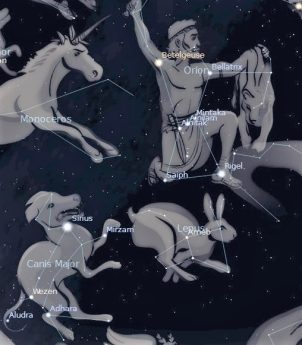This Week’s Sky at a Glance, 2025 Jan 4 – Jan 11
This Week’s Sky at a Glance, 2025 Jan 4 – Jan 11
Looking at a constellation it is easy to imagine its component stars being fairly close together in space, as if it is an actual body. Let us look at two prominent winter constellations to see if that is true. Surely the three stars of Orion’s Belt are equidistant; at first glance they appear to be almost equally bright. Alnitak, the left star, is 1260 light years (ly) away, slightly farther than dimmer Mintaka on the right. Alnilam, the middle star, is much farther at 2000 ly. Saiph and bright Rigel, marking Orion’s feet or knees, are 650 ly and 860 ly distant, respectively. In the giant hunter’s shoulders orange Betelgeuse is about 550 ly away and Bellatrix is 250 ly.
Following the belt to the lower left we arrive at Canis Major, the Big Dog, with brilliant Sirius at its heart. Sirius is the brightest star of the night sky and the closest naked-eye star we can see in New Brunswick at 8.6 ly (only 82 trillion kilometres), which is the main reason it is the brightest. If Rigel were that close it would be about as bright as the quarter Moon. Adhara, in the dog’s rear leg, is the 23rd brightest star and 400 ly away, Wezen in the dog’s butt is 1600 ly, and the tail star Aludra is 1100 ly distant. Obviously, the constellations are just chance alignments of stars from our viewpoint. The distances cited here are taken from Wikipedia, but other sources could vary significantly as stellar distances are difficult to determine precisely.
This Week in the Solar System
Saturday’s sunrise in Moncton is at 8:01 and sunset will occur at 4:47, giving 8 hours, 46 minutes of daylight (8:03 and 4:55 in Saint John). Next Saturday the Sun will rise at 7:59 and set at 4:55, giving 8 hours, 56 minutes of daylight (8:01 and 5:03 in Saint John). The Earth is at perihelion, its minimum distance from the Sun, this Saturday morning.
This Saturday the Moon cruises just below Saturn between noon and 1 pm, a challenge for telescope users. The Moon is at first quarter on Monday and it passes through the Pleiades star cluster on Thursday, an event worth watching with binoculars or a telescope throughout the entire evening. The following evening it is within a binocular view above Jupiter. Venus dominates the early evening sky in the southwest, setting around 9 pm and heading toward a meet-up with Saturn. On Wednesday evening telescope users might see Jupiter’s Red Spot for two hours centred on 6:30, its moon Europa emerge from eclipse at 7:44, and Io disappear behind the planet a few hours later. Mars is brightening as it retrogrades through Cancer, heading toward opposition in mid-January. Mercury rises more than an hour before sunrise and remains bright enough to be an easy binocular target in the southeast.
The Saint John Astronomy Club meets in the Rockwood Park Interpretation Centre at 7 pm this Saturday. Tune in to the Sunday Night Astronomy Show at 8 pm on the YouTube channel and Facebook page of Astronomy by the Bay.

